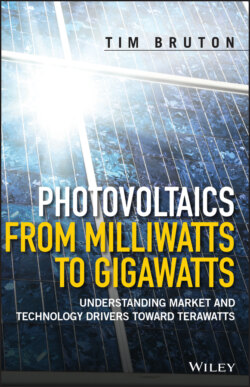Читать книгу Photovoltaics from Milliwatts to Gigawatts - Tim Bruton - Страница 17
1.3 Photovoltaics Demonstrates Success
ОглавлениеWith the highly visible success of the Vanguard 1 mission, photovoltaics became the technology of choice for powering satellites. Nevertheless, some scepticism remained in place, and photovoltaics was seen purely as a stopgap measure until atomic batteries were developed. Others thought that while photovoltaics was acceptable for the simple early satellites, it would not provide enough power for the more sophisticated ones – not to mention space stations – envisaged for the future [37].
Immediate confirmation of the value of solar cells in space was given by the Russians, who launched the Sputnik 3 on 5 May 1958, also as part of the International Geophysical Year. In addition to a number of scientific instruments, Sputnik 3 included a solar cell‐powered transmitter [38]. The Russians had been monitoring Bell Laboratories’ work and had developed their own cells [37]. One Russian scientist stated in 1958 that ‘Solar batteries … would ultimately become the main source of power in space’. With hindsight, it is easy to see how these predictions became true. Space was the obvious market for solar cells. Solar insolation is 40% higher in space than on the earth’s surface. Satellites are the ultimate off‐grid market, with no maintenance possible after launch until at least the 1990s. They are free of the day–night constraints of terrestrial systems. Price is not an issue, given the high cost of launchings satellites. In any case, with increasing production volume and the general growth of the silicon semiconductor infrastructure, solar cell costs had fallen to $100/W by 1970.
Space offered some challenges, however. It had been noted by RCA Laboratories that in its experiments to produce electro‐voltaic cells, beta radiation from a Sr90‐Y90 source had seriously degraded solar cell performance [39]. Initially, figures for cosmic radiation were extrapolated from high‐altitude balloon flights, and it was calculated that it would take 105 years for there to be a 25% loss of cell efficiency. However, the Explorer 1 satellite, launched in 1958, found that in the yet to be recognised van Allen radiation belt, cosmic radiation was 104 times higher than that estimated from balloons, meaning unshielded solar cell life would be only 10 years [39]. This was mitigated by the discovery that a quartz or sapphire cover could significantly reduce the amount of radiation reaching a cell, prolonging its active life. Nevertheless, radiation resistance of solar cells became a major topic of research in subsequent years, and end‐of‐life cell efficiency (rather than efficiency at launch) a major consideration. Research at the USARDL found that reversing the structure of the original Bell Labs cells by producing a shallow n doped layer via phosphorus diffusion into a p type substrate increased radiation resistance by an order of magnitude [40]. As a result, n on p solar cells became the preferred structure for use in space. It was also much easier to create shallow diffusions with phosphorus than with boron.
The mid 1950s proved a fertile time for understanding of the p–n junction solar cell. Van Roosbroeck and Pfann predicted in 1954 that such a cell could reach 18% efficiency [41]. A later paper by Prince calculated junction depths and series resistance and concluded that 21.7% efficiency was the maximum possible in silicon, but that 10% was a practical limit [42]. This analysis enabled Bell Labs to move forward from its 6% cell to a 10% one, although incorrect data had been used for the absorption depth of solar photons. Prince also concluded that the optimum bandgap would lie between 1.0 and 1.6 eV. As well as providing the basis for further work in silicon, this also stimulated research into other semiconductors such as cadmium telluride, indium phosphide, and gallium arsenide [39]. Interestingly, a paper by Jackson demonstrated how solar cells of different bandgaps could be stacked on each other and that a tandem cell with bandgaps of 0.95, 1.34 and 1.91 eV would have an efficiency of 37% assuming the cell would operate as well as the single junction cell of that time [43]. These papers paved the way to the definitive work on ultimate solar cell efficiencies for semiconductors of different bandgaps, published by Schockley and Quiesser in 1961 [44]. This ultimate efficiency was modelled by assuming 100% absorption of incoming light and no losses within the solar cell. The main losses were imposed by the limitation of the semiconductor bandgap. Photons with energy less than the bandgap could not excite electrons into the conduction band, and the energy was absorbed as heat. Photons with energy above the bandgap created an electron–hole pair, but with excess energy in the conduction band, which had many empty lower‐energy states close to the band edge. The excited electrons lost their energy again by heat and occupied those empty energy states. Schockley and Quiesser found the optimum bandgap was 1.4 eV, giving an efficiency of around 30%. Finding ways to exceed this Shockley–Quiesser limit has been the topic of much research and is discussed in Chapters 7 and 8.
